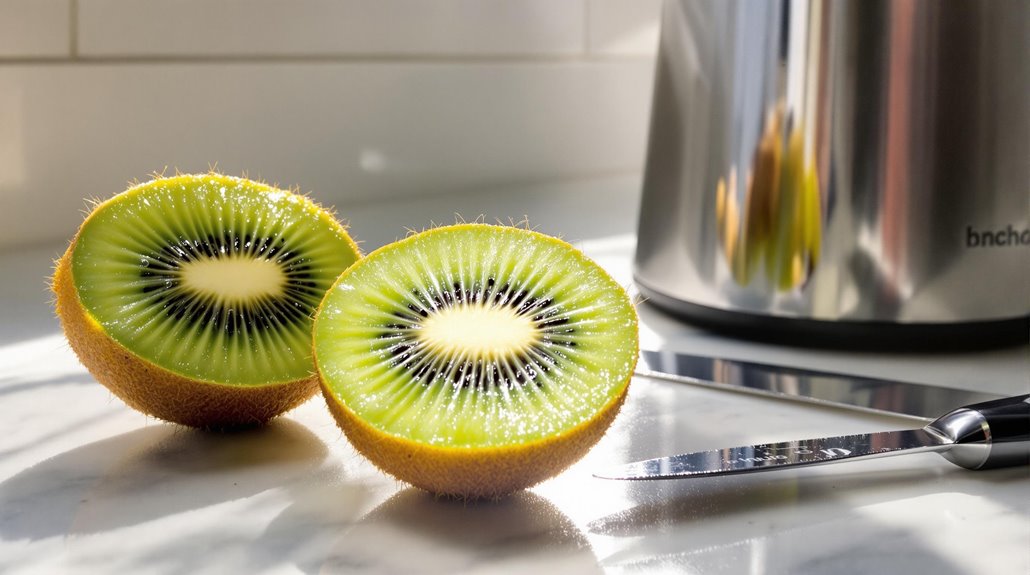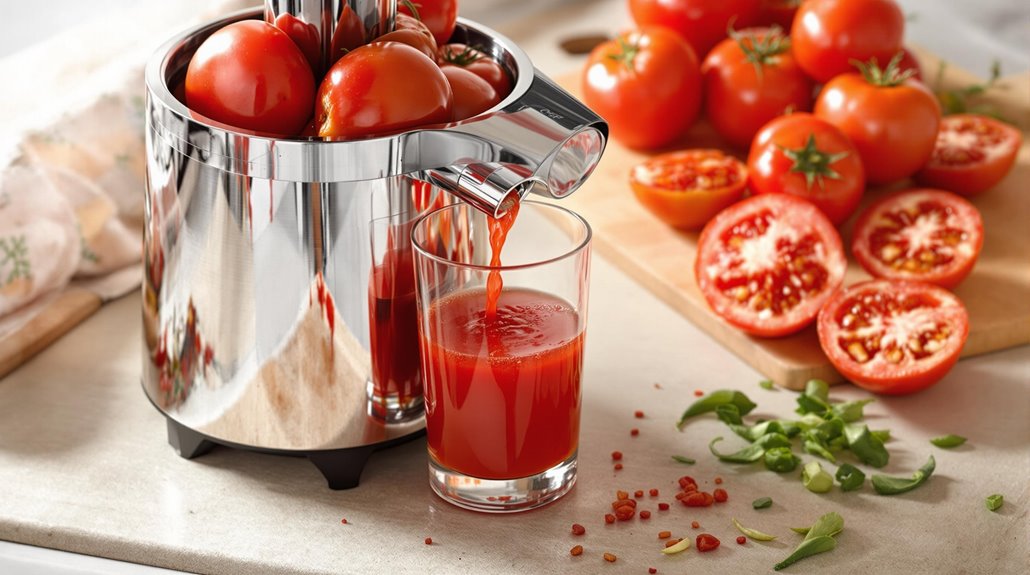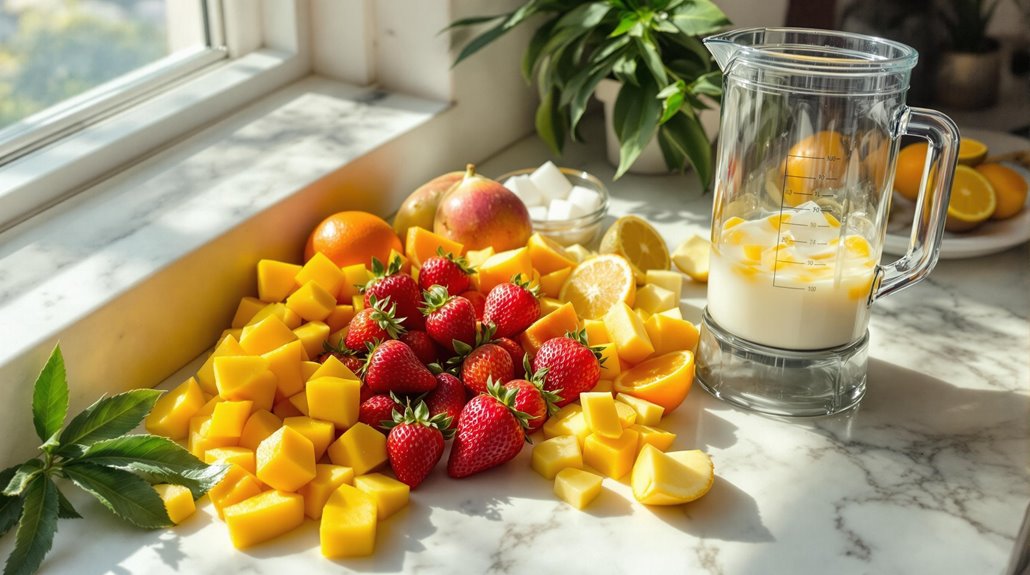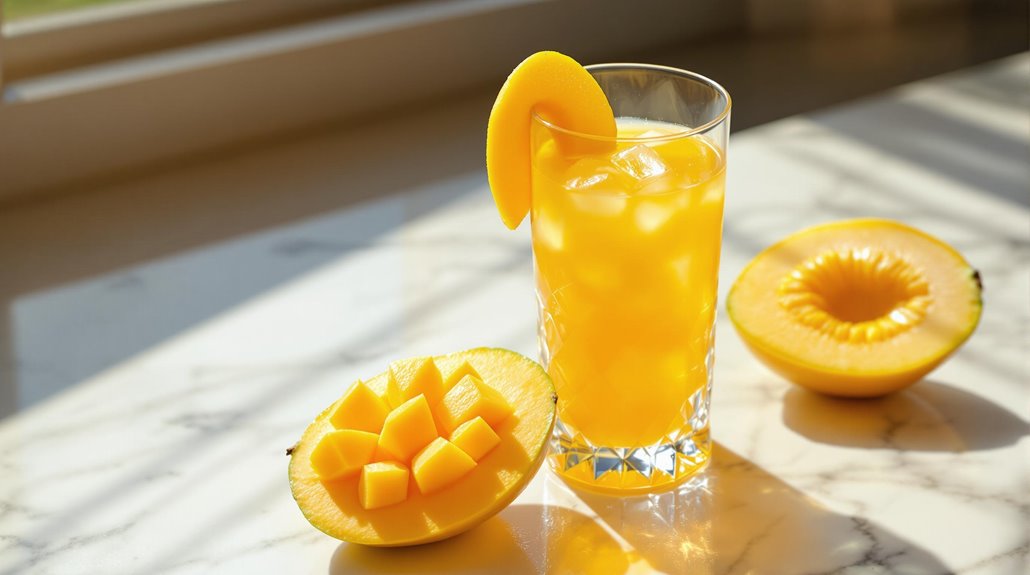Do You Peel Mango Before Juicing?
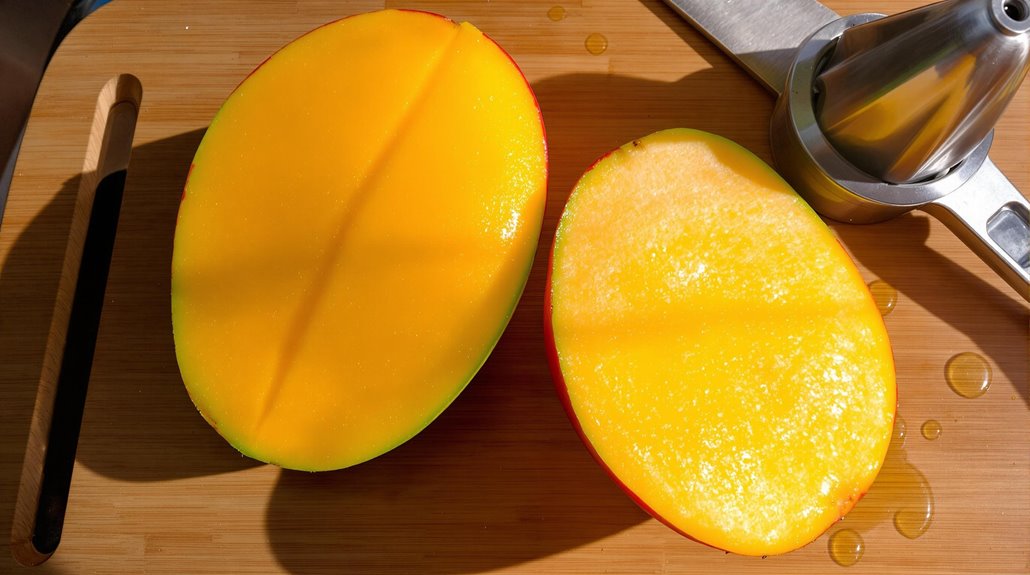
You'll definitely want to peel your mango before juicing it. The skin contains compounds that can make your juice taste bitter and unpleasant, while potentially damaging your juicer's blades or clogging the strainer. Simply wash the mango, cut it into chunks, and remove both the skin and seed before processing. Using peeled mango guarantees you'll get the most nutrients and best-tasting juice. Explore more ways to perfect your mango juicing technique below.
Why Peeling Mango Matters
Though you might be tempted to throw a whole mango into your juicer, peeling the fruit first is essential for both safety and quality. The mango's thick skin contains compounds that can make your juice taste bitter and unpleasant, compromising the sweet flavor you're looking for.
When you're juicing with the peel on, you'll likely run into mechanical issues too. The tough skin can clog your juicer's strainer and potentially damage the machine's blades. Plus, the peel doesn't contain significant nutrients that you'd miss out on by removing it.
Using a centrifugal force juicer will efficiently separate the mango's juice from its pulp once peeled.
Steps to Properly Peel a Mango
Once you're ready to juice your mango, start with a clean, ripe fruit and gather your tools: a sharp knife and a clean cutting board. The tough texture of mango skin can cause clogging in your juicer and affect the flavor of your drink, so proper peeling is essential.
Begin by washing your mango thoroughly under cold running water to remove any dirt or residue. Using your sharp knife, carefully cut the mango into manageable chunks while removing both the skin and seed. Don't try to juice the skin, as it won't process well and could cause digestive issues. Discard both the peel and seed, keeping only the flesh for juicing. The peeled chunks are now ready for processing, ensuring you'll get the most nutrients and best-tasting juice from your mango. Similar to tropical fruit salads, mangos can be combined with papaya for an extra nutritious juice blend.
Health Benefits of Fresh Mango Juice
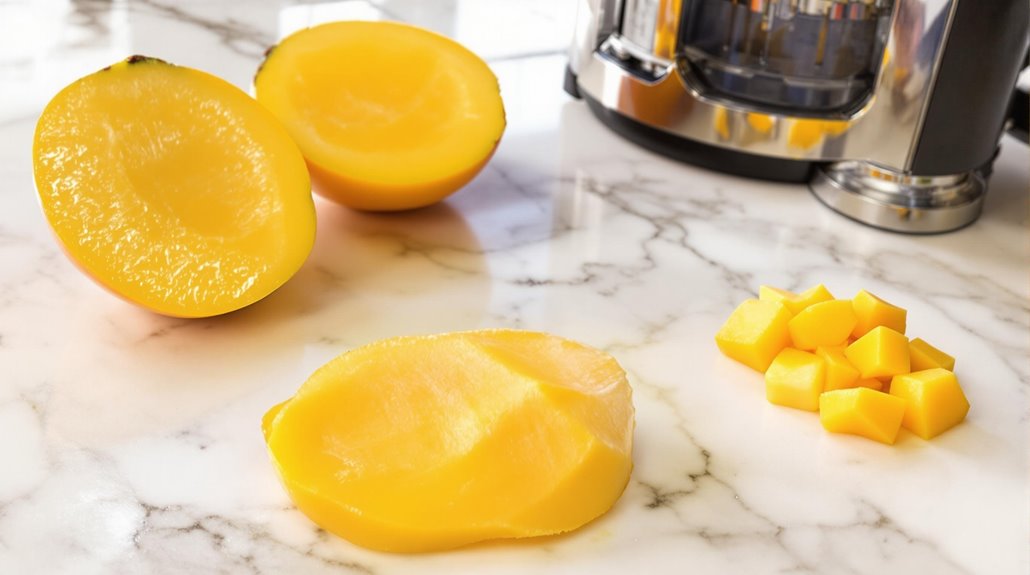
Fresh mango juice offers five extraordinary health benefits that make it an excellent addition to your diet. You'll get a powerful [increase] of vitamins A and C, which strengthen your immune system and promote healthy skin. The antioxidants, particularly mangiferin, work to reduce inflammation while fighting harmful free radicals in your body.
Potassium-rich mango juice supports your cardiovascular health and helps maintain healthy blood pressure. Natural fiber aids digestion and helps regulate blood sugar levels. The juice's rich iron content helps prevent anemia and supports red blood cell production. Carotenoids and polyphenols provide protection against certain types of cancer. The combination of vitamins and antioxidants promotes overall wellness.
Whether you're looking to [augment] your immune system or improve your heart health, fresh mango juice delivers multiple health benefits in every glass. It's a delicious way to support your body's natural functions while enjoying the sweet, tropical taste.
Best Tools for Mango Juicing
To get the most from mango's impressive health benefits, you'll need the right equipment for juicing. The best tool for mango juicing is a masticating juicer, which efficiently handles the fruit's fibrous nature and soft texture while extracting maximum juice.
You'll also find success using a blender or food processor, as these appliances effectively puree the mango's pulp. If you're using a high-powered blender, you might need to strain the juice afterward to achieve your desired consistency.
However, you'll want to avoid using a centrifugal juicer, as it struggles to process mango's soft, pulpy flesh effectively. Skip the handheld citrus juicers too - they're not designed to handle mango's unique texture and will leave you frustrated with poor results.
Common Mistakes When Juicing Mangoes
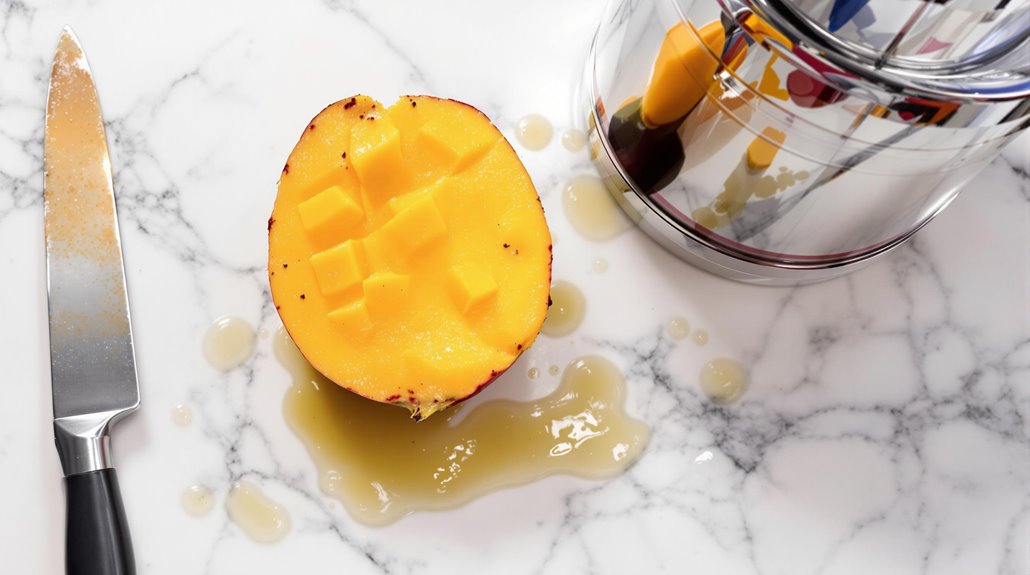
While juicing mangoes can be a pleasing way to enjoy this tropical fruit, many people make common mistakes that compromise their results. If you're looking to create smooth, delicious mango juice, you'll want to avoid these critical errors.
- Trying to juice mangoes with the skin and pit intact can damage your juicer and prevent proper extraction
- Using a regular juicer instead of a blender can result in stringy, fibrous pulp and poor juice quality
- Selecting overly fibrous mango varieties makes the process messy and affects the final texture
- Skipping the strainer step leaves you with cloudy juice full of unwanted pulp
To get the best results, always peel your mango, remove the pit, and cut it into manageable chunks before processing. Remember to strain the juice afterward for a smooth, pleasant drinking experience.
Storage and Shelf Life Tips
Properly storing your freshly made mango juice can mean the difference between enjoying it for days or watching it spoil quickly. To make the most of this healthy fruit beverage, you'll need to store it in an airtight container in your refrigerator, where it'll stay fresh for 3-5 days.
If you're trying to extend the shelf life of your juice, try adding a squeeze of lemon while making it. This simple trick helps preserve both color and health benefits. To hard-freeze portions for later use, cut your storage time anxiety by pouring the juice into ice cube trays - they'll last 6-8 months in the freezer.
For the best results, keep your juice in dark containers or away from light sources, as this will help prevent oxidation and maintain the fresh-squeezed taste you love.
Creative Mango Juice Combinations
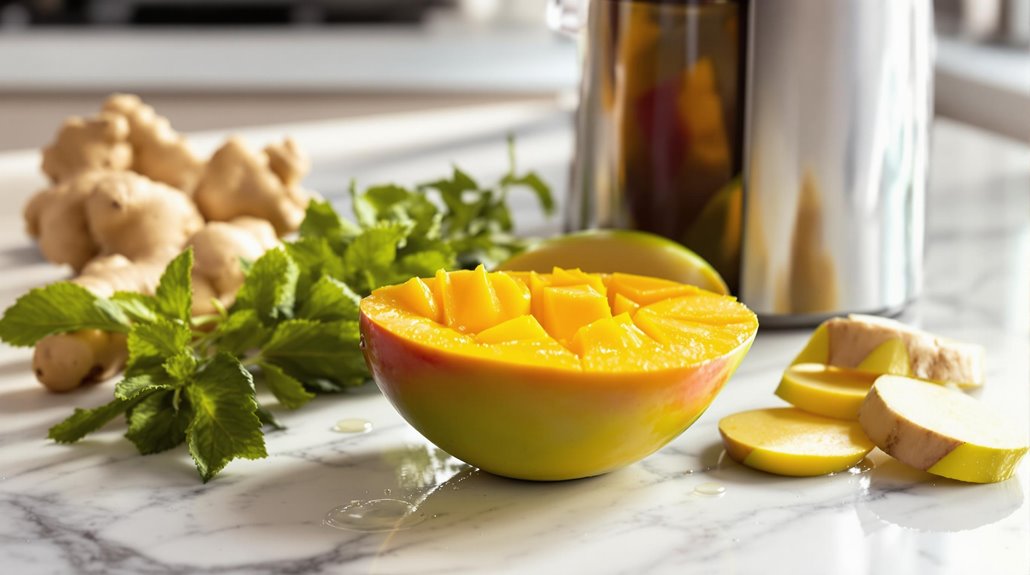
Although mango juice is wonderful on its own, mixing it with complementary ingredients can enhance your beverage game to new heights. You'll find endless possibilities when combining mango juice with other fruits like pineapple, orange, or banana.
For a nutritious twist, try blending it into smoothies with spinach, Greek yogurt, and chia seeds. Adding lime juice or zest can balance the sweetness while creating an exquisite tropical flavor.
- Classic tropical blend: Mango juice with pineapple and orange
- Green power smoothie: Mango juice, spinach, and Greek yogurt
- Protein-packed refresher: Mango juice with banana and chia seeds
- Citrus fusion: Mango juice with a splash of lime juice and zest
These combinations not only taste superb but also elevate your drink's nutritional value.
Expert Tips for Maximum Juice Yield
To maximize your mango juice yield, peeling the fruit before processing is vital for the best results. When you need to peel mangos, remove both the skin and pit to prevent clogging your juicer and guarantee a tastier juice. Choose ripe mangos with smooth, soft flesh rather than fibrous varieties for optimal performance.
Cut your peeled mangos into manageable chunks and blend them with water before straining. This two-step juicing process helps extract more liquid from the fruit. Avoid juicing the hard core, as it can affect the juice's quality and potentially damage your equipment.
When you juice mangos, remember that separating soft and hard ingredients is crucial for efficiency. While the peel contains nutrients, removing it creates a smoother consistency and prevents mechanical issues during extraction.

